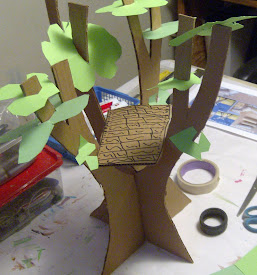It's true. We art teachers love cardboard. We collect it. We divide it by size and into piles of useful, great, and amazing cardboard. Thin and bendable, corrugated, double corrugated, thick like wood; we love it all. It's like gold to us. What can we do with cardboard? What can't we do with cardboard?
We stock up on cardboard tubes of all sizes. We love cardboard egg cartons and oddly shaped fruit packing cardboard. All the better to make stuff with!
Such as this 3-dimensional relief sculpture of an awesome dragon.
It was first constructed from cardboard, carboard tubes, tissue, masking tape, and other recycled or found objects. Then the background was covered with tissue paper and the dragon was painted.
This cardboard dragon sculpture was constructed during a two-day cardboard assemblage, construction, sculptural workshop. This type of 3D art-making is very appealing to young artists!
To make a free-standing 3-dimensional dragon, this artist first drew a picture of the dragon idea on paper. Then she drew the dragon's main body on extra thick corrugated cardboard and the other parts thinner cardboard, including wings, to be cut out and assembled.
The parts of the dragon were then glued together and the webbing was added to the wings. (We recycled a plastic birthday party table covering for that because it was thin - but stronger than tissue paper.) Then the entire dragon was painted.
This project was a bit different. The artist wanted to build a treehouse, tree and all. So she started with a simple, free-standing tree, complete with branches full of leaves. Then she added the basic tree house platform - made of solid wood, as you can see (smile).
Now she was able to add the roof, the ladder, a tire swing, and a water slide, complete with a pool full of water toys!
Our inspiration for this workshop* was British artist and teacher Darrell Wakelam's "three-dimensional sculptural work using simple techniques and cheap, everyday materials, mainly scrap cardboard and paper."
* other than the piles of cardboard kept on hand by me, as previously disclosed above.
Just to be sure, I decided to use Darrell's techniques to create my own cardboard relief sculpture prior to offering this workshop, of course. Strictly research.
I made this zebra, and it was fun!
For oodles of ideas and resources relating to using cardboard and other recyclables for making three-dimensional assemblages and sculptures, you can visit Darrell's website at
darrellwakelam.com.



















